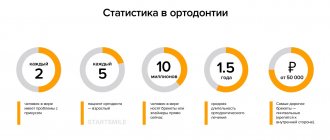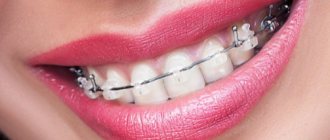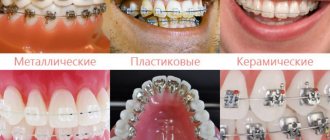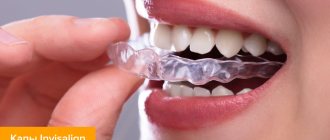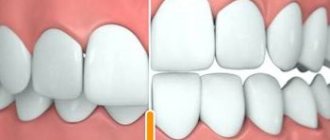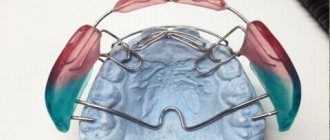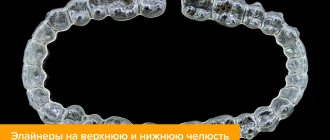Correcting the bite of an adult is a long and complex process, because you need to not only change the position of the teeth, but also correct disturbances in the usual functioning of the muscles, ligaments, spine and even the respiratory system. Therefore, the best results are achieved by an integrated approach, in which different specialists are involved in the treatment.
Correcting a bite is a complex treatment that requires a whole team of doctors
Dentist-therapist
This doctor is needed by almost everyone who is preparing to correct their bite. The fact is that a mandatory requirement before treatment is the elimination of all foci of caries, even superficial ones, and they are often impossible to notice on their own. It is also necessary to treat the common fissure caries (those that form in the recesses of the chewing teeth). After treatment, you need to carry out ultrasonic cleaning to remove tartar and Air Flow cleaning to completely remove soft plaque and polish your teeth. After such preparation, maintaining hygiene with braces or aligners will be easier.
Gnathologist
Gnathology is a branch of dentistry that studies the problems of the dentofacial apparatus and solves problems associated with its functioning. Simply put, gnathology, as a medical specialty, deals with the pathology of the jaws.
A dentist who has specialized in gnathology is called a gnathologist. This is a very rare medical specialty, and not every clinic employs doctors with such a narrow specialization. At Kostamed, the chief physician of the clinic, Yuri Aleksandrovich Kostylev, works as a dentist-gnathologist.
Goals and objectives of gnathology
The main task of gnathology is to assess the functional status of all components of the dental system: masticatory muscles, temporomandibular joint, periodontium, dentition and individual teeth. Gnathology studies not just the static state of all these elements - using special research methods, dynamic parameters are assessed, for example, the biomechanics of chewing. Dentists who have specialized in gnathology study the geometry of the chewing part of the skull and determine the aesthetic relationship between the proportions of the jaws and the rest of the face.
The purpose of gnathological studies is to identify the pathology of the morphofunctional state of the dental system. The data obtained allows specialists to correct existing violations. A consultation with a qualified gnathologist dentist, which can be done in our clinic, will allow you to:
- determine the optimal scheme for correcting violations of intermaxillary interaction - a specialist will advise how best to correct the bite;
- develop tactics for treating pathology of the TMJ and lower jaw;
- optimize the selection and production of dentures;
- harmonize the work of the masticatory muscles.
What does a gnathologist do?
During the implementation of special examination methods, elements of pathological interaction between the upper and lower jaws, tooth surfaces, masticatory muscles, and dentition are identified. This sometimes requires instrumental examinations:
- Electronic condylography is the main method for diagnosing TMJ dysfunction.
- Rheoarthrography.
- MRI and CT scan of the TMJ and other parts of the dental system.
- Phonoarthrography.
- Axiography.
You should not think that a gnathologist uses only instrumental research methods - the classic examination and palpation of the muscles of the face and jaws has not been canceled. These elementary examination methods allow a competent specialist to immediately make a preliminary diagnosis and determine the scope of a detailed examination and treatment tactics.
Treatment of gnathological disorders by a gnathologist involves the use of therapeutic and diagnostic devices, such as:
- disconnecting and centering tires;
- stabilizing tires;
- relaxation bite blocks.
Gnathological treatment often requires selective grinding of teeth to eliminate pathological dental occlusion.
Important! Occlusion in gnathology refers to the contact or closure of the teeth of the upper and lower jaw.
In cases where the help of a gnathologist alone is not enough, orthodontists are involved in the treatment of the patient. They help to restore the normal relationship of teeth through prosthetics. One of the advantages of our clinic is that we have all the necessary specialists. This allows you to optimize the treatment process and not waste time searching for dentists of the right profile.
Problems requiring the help of a gnathologist:
- limited opening of the oral cavity;
- defective occlusion of the dentition;
- to determine the amplitude with which the lower jaw moves;
- complaints of clicking and crunching in the temporomandibular joint when chewing;
- to determine the optimal type of dentures during the implantation procedure;
- asymmetry of teeth closure;
- bruxism.
Tinnitus of unknown origin, tension in the masticatory muscles and pain during chewing also require consultation with a gnathologist. Often, consultation with this specialist is required after dental and orthodontic treatment. Often, a poorly executed filling, an incorrectly made or incorrectly installed denture are the source of gnathological problems.
This is interesting! Some problems in the gnathology profile are solved with the help of injections of botulinum toxin, which has the property of relaxing muscles. This effect will relieve pathological spasm and correct the bite.
Cost of treatment with a gnathologist at the Costamed clinic
Dentistry "Costamed" offers a comprehensive and effective solution to any dental problems, including those related to gnathology. The cost of the most detailed consultation with a gnathologist in our clinic is 5,000 rubles.
During the consultation, a comprehensive study of the functional status of the dental system is carried out. We solve both technical and aesthetic problems. During treatment, our specialists take into account the individual harmonious features of the face.
By contacting Kostamed dentistry, you are guaranteed to get rid of bite problems and pain when chewing. Our doctors will help restore the functioning of the TMJ after jaw injuries of any complexity and in case of chronic diseases of the dental system.
Make an appointment with a gnathologist in Perm by phone or through the online registration form on the website. You can call around the clock - at any time of the day, a specialist will answer the phone call and you will choose a convenient time for a consultation with a gnathologist.
Dentist-implantologist
Such a specialist is involved in treatment planning when there is a need for prosthetics.
If at the start of treatment some teeth are missing, then two tactics are considered.
- Tighten the spaces between teeth so that adjacent teeth replace the missing one. This is possible if, for example, the second molar (seven) was removed, but the third (eight, wisdom tooth) erupted. Functionally, these teeth differ little, so it is justified to move the figure eight to the place of the lost 7th tooth. But if we are talking about other teeth, then this treatment method can lead to asymmetry and an aesthetically unattractive result.
- Prepare the site for subsequent prosthetics. To do this, the teeth are not tightened, but rather, the space between them is expanded. During treatment with an orthodontist, you will have to spend some time with a noticeable gap in the row of teeth, and then contact an implantologist. This is a longer method of treatment, but the result is worth it: all the roots of the teeth will be in place, and an implant will be installed to replace the lost tooth.
This is what preparation for implantation looks like: with the help of braces, a place for the implant is prepared.
Sometimes the implantologist himself refers patients to the orthodontist. This happens if a patient applies for implantation, not knowing that malocclusion is an obstacle to prosthetics. In this case, the correct order of treatment is as follows: first correct the bite with orthodontic treatment, and only then install implants.
Basic information about gnathology
Gnathology is a branch of dentistry devoted to the work of the dentofacial apparatus and all its components - nerves, bones, chewing and facial muscles, periodontal tissues, joints, teeth. It is gnathology that is responsible for the correct structure of the jaw, normal chewing of food, and a beautiful smile.
Every dentist can have minimal knowledge and skills in this area, but when solving more complex and specific problems, you will definitely have to turn to a specialist - a professional gnathologist.
Orthopedic surgeon
An orthopedic surgeon deals with all problems of the musculoskeletal system.
If your posture is poor, the lower jaw shifts and it “pulls” the bite along with it.
All muscles and ligaments in the body work harmoniously. If bite asymmetry occurs, compensation inevitably occurs in the cervical or shoulder region, hence muscle strain and poor circulation. Almost all orthodontic patients have some degree of scoliosis or stooping. Although it is almost impossible to completely correct this problem in adults, it can be compensated for, thereby supporting treatment. Often, treatment aimed at relieving muscle spasms helps progress in correcting the bite, in addition, an integrated approach reduces the risk of relapses in the future, after treatment is completed.
An orthopedic surgeon can prescribe treatment that will help relieve muscle tension and eliminate tension in the shoulder, thoracic, and lumbar spine. This could be massages, physical therapy or physiotherapy.
Orthodontist: what he does and what he treats
The services of the dental clinic include orthodontic treatment. Orthodontics is a branch of dentistry that studies the causes of dental anomalies, methods for their diagnosis and correction. Dental anomalies are widespread among diseases of the maxillofacial system.
An orthodontist is a doctor who diagnoses and treats dental anomalies in children and adults. This is a narrow dental specialty: the doctor undergoes five years of training at a medical institute, then two years of residency in the specialty “Orthodontics”. This doctor treats adults and children.
Maxillofacial surgeon
This specialist is needed for those whose bite pathology requires surgery. Usually this is a pronounced mesial bite or a combination of several disorders, especially with a pathological narrowing of the jaw. The operation itself is only one of the stages of treatment; in preparation for it and after it, you still need to wear braces to stabilize the occlusion (closing of the teeth) and improve the aesthetics of the smile.
Surgical correction of the bite: the jaws are given the correct shape, but the teeth still need alignment
How does an orthodontist perform diagnostics?
An examination and diagnosis is required before starting treatment. During the consultation, the orthodontist conducts:
- collection of patient complaints and anamnesis data;
- examination of the patient’s face: symmetry, proportionality, and facial profile are assessed;
- when examining the oral cavity, the doctor fills out the dental formula, determines the bite, examines the frenulum of the lips, tongue, etc.;
If parents and a child come to the clinic for orthodontic treatment, the doctor conducts a survey of the parents about the child’s condition, its characteristics, etc.
Additional research methods in orthodontics include:
- Measuring plaster models of jaws: the doctor takes impressions of the jaws and casts plaster models. They are used to measure the dentition, diagnose their symmetry, and more.
- Orthopantomography (OPTG): the resulting image shows all the teeth, their roots, rudiments, and the structure of the bone tissue of the jaws.
- Teleradiography (TRG) in the direct and lateral surfaces: allows you to study the structure of the facial skeleton, establish an accurate diagnosis, and also predict the success of treatment.
During the consultation, the orthodontist will tell you what studies will be required in this case and what treatment methods are possible.
D
Otolaryngologist
Cases where there is a direct connection between problems with the respiratory system and bite are not frequent, but sometimes a consultation with an ENT doctor is necessary. This is especially true for those who, before contacting an orthodontist, suffered from chronic ENT diseases with frequent exacerbations and impaired nasal breathing.
At the first appointment, the orthodontist collects information about the patient and asks about other diseases. A complete picture of your health condition will help you prescribe comprehensive treatment to achieve the best result and minimize the risk of regression.
What diseases are most often treated by an orthodontist?
Most often, patients come to this doctor to correct their malocclusion. Moreover, patients notice such pathologies
Among the pathological bite are:
- Mesial (progenic): in the anterior region, the lower incisors overlap the upper ones or form a direct closure. With this pathology, the patient experiences protrusion of the lower jaw.
- Distal: The upper front teeth protrude above the lower teeth. The front teeth do not close together; upon examination, a gap is visible between them. The lower jaw is behind the upper jaw.
- Crossbite: there is a violation of the facial configuration, a displacement of the chin towards the lips.
Treatment of malocclusion must be started in a timely manner to avoid complications. We recommend that you consult with an orthodontist to determine if your situation has an overbite and how to treat it.
Caring for installed devices
Removable and non-removable structures differ in care, but the basic principles are the same for any device:
- Daily cleaning. Removable appliances are removed and washed with a toothbrush or orthodontic brush under warm water. Toothpaste or soap is used as a cleanser. Fixed structures can be cleaned with a toothbrush during cleaning.
- An irrigator is used for effective cleansing.
- It is mandatory to rinse your mouth with warm water after every meal.
- Increased loads are excluded. You should not chew candies, nuts, crackers, cabbage stalks and other hard foods. It is important to remove candies with caramel, chewing gum, and toffees from your diet.
- Removable structures are stored in an individual container, which is washed weekly. Every two weeks, the devices are immersed in a disinfectant solution for eight hours, then thoroughly washed with running water.
- White and transparent structures can be stained by tea, coffee, boiled beets or carrots, which is also important to consider.
When is TMJ surgery performed?
If conservative therapy does not bring the desired results, a decision is made about the need for surgery on the temporomandibular joint. In such cases, the surgeon organizes one of the following types of interventions:
- TMJ puncture;
- removal of part of the pathological tissue, correction of the location of the cartilaginous disc and condyle;
- intra-articular surgery if a tumor process is diagnosed and bone tissue is destroyed.
The decision on the advisability of any operation is made by a medical council.
Dentistry for those who love to smile
+7
Make an appointment
What does malocclusion mean?
Violation of the normal position of the jaws and teeth leads to unpleasant consequences - rapid abrasion and destruction of protruding elements, disruption of the acts of chewing and breathing, and changes in the timing of teething. Children often bite their cheeks and constantly have inflammatory diseases of the oral mucosa.
Signs of a malocclusion:
- crowded teeth;
- widening the gap between teeth;
- incorrect position of the jaw when closing the mouth, chewing;
- tooth growth outward, inward, or sideways;
- extra teeth.
In dental practice, one often encounters protruding canines, sparse interdental spaces, and overlapping teeth.
How does an orthodontist treat?
Correcting a malocclusion is possible in several ways:
- The bracket system is a complex in design, but highly effective system in modern orthodontics. It allows you to create a functional and aesthetic optimum in the human dental system. Suitable not only for children. In adulthood, it is also possible to correct the bite with braces.
Braces are structures made of special metal locks and arches installed on the teeth. They are non-removable. Correcting the bite requires long-term wearing (from a year or more). The duration of wearing depends on the initial situation, the age of the patient and the characteristics of the maxillofacial system.
- Orthodontic plates are special structures that have a plastic base and various metal fasteners, screws, hinges, and springs. They are used in children, starting with primary occlusion, as well as during the period of teeth change: up to 12-14 years. They allow you to expand, shorten, lengthen the dentition, move teeth, change their position and much more.
Plates are removable orthodontic structures that must be maintained. The type of plate and duration of wearing is determined by the orthodontist. The production of plates takes place in a dental laboratory using individual casts of the jaws.
The success of treatment with plates in childhood depends not only on the correct manufacture of the desired design, but also on a responsible approach to wearing the plate by parents and the child. You should strictly follow the doctor’s recommendations, wear the plate for the required number of hours a day, and perform the necessary hygiene procedures.
Custom sports mouth guards
An orthodontist not only treats various pathologies, but also helps prevent dental injuries. Contact sports (boxing, hockey, football) require protection of the front teeth from accidental injury.
To protect the dentition, individual mouthguards are made. They fit precisely to the teeth, are securely fixed in the oral cavity and protect athletes from dental injuries. Made from hypoallergenic materials, used for adults and children.
To make such a mouth guard, you will need two visits to the doctor:
- Taking impressions of the jaws. They are sent to the laboratory, where plaster models are cast, and the mouthguard itself is then cast.
- When the mouth guard is ready, the patient is invited to try it on and is given the design. The doctor gives recommendations on how to care for the mouthguard.

